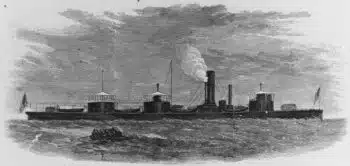The United States has a material, vested interest in obstructing progress on climate change. This argument, laid out by Amitav Ghosh in his 2021 book The Nutmeg’s Curse, is crucial for understanding the politics not just of climate change, but of the world: everything from the American trade war against Chinese renewable technologies to the ongoing genocide in Gaza can be linked to it.
It also helps explain the role that the United States has played in international climate politics for the last three decades. Liberals in the West tend to blame the dismal American climate record—and the Canadian one, too, though we are a less pivotal player—on fossil fuel-funded climate denialism, or, if they are truly pushing their analytical limits, the role of “special interests” in politics. But this story implies a weak U.S. state and a remarkably easily bought public (by one estimate, Exxon spent just $33 million on climate denial campaigns over 18 years), with both operating, effectively, as arms of privately owned, U.S.-based transnational oil and gas companies. This insistence is despite the fact that the U.S. itself didn’t become the dominant producer of oil and gas that it is today until the Obama era. The U.S. economy relied on oil and gas only in the same sense as the global economy did, not as a country centred around production.
There is no doubt that fossil fuel companies and the much broader network of fossil capital that they represent do play a significant political role, but blaming them entirely for American obstructionism turns the geopolitical roles of both the U.S. state, and oil itself, on their head. Attributing America’s failure to act on climate wholly to denialism obscures something far more fundamental: American empire is inextricably linked with fossil fuels, and to mitigate climate change, it must come to an end.
The fossil fuel advantage: unstoppable military power
Ghosh argues that there is—and has been, for the entire fossil fuel era—a direct correspondence between “a country’s ability to project military force… and the size of its carbon footprint.” When energy transitions have occurred in the past (to the extent they have occurred)—from the sun, wind, and biomass of the pre-industrial era to coal (“steam”) in the 19th century, and then to oil and gas in the 20th—they have been primarily military transitions. He illustrates this by pointing to the British attack on China during the First Opium War of 1839—42: they sent just a single brand-new “steam-powered battleship called the Nemesis,” and, with that one ship, absolutely devastated the Chinese, easily securing victory. Around the same time, as Andreas Malm recently explored, the British also used a steamship to devastate Palestine as part of an imperialist war to force Egypt to enter a “free trade” agreement. That steamship levelled entire cities in Palestine—cities that have been demolished repeatedly since then, over two ensuing centuries of colonial assault.
These new steamships, fuelled by coal, were unstoppable and allowed the British to quickly establish a global, fossil-fuelled empire.
The dependence of its new empire on fossil fuels seeded something of a vicious cycle: Britain’s military, powered by these fuels, took on the role of securing and protecting access to them. The U.S. military would take over the same role as it assumed the helm of empire in the mid-20th century—and, indeed, the last hundred years have been rife with examples of imperial warfare aimed plainly at securing and maintaining access to fossil fuels.
Renewables and the war economy: Nothing to gain
One might ask, at this point: What makes empire and its military—the U.S. military, today—specifically reliant on fossil fuels? Why can’t they lead a transition to renewable energy, as some social democrats in Western countries call for? There are two major reasons for this.
The first has to do with the energy sources themselves. The move from wind-powered warships to steam brought with it a tactical advantage that effectively guaranteed victory—a guarantee rooted in coal’s energy density and its ability to be used on demand. Renewable energy lacks both of those benefits: even the civilian renewables transition is plagued by the question of intermittency: how to get through the inevitable periods during which the sun and the wind aren’t providing enough power. There are solutions—storage—but scale is a major problem. When one considers that the military accounts for a large portion of U.S. energy use, and most of that energy is currently derived from fossil fuels, the absurdity of a complete military transition starts to become apparent.
Energy density is an issue, too: an F-16 uses 1,700 gallons of fuel per hour. In embedded energy terms, that’s roughly equivalent to 60,000 kilowatt hours, the annual electricity consumption of six high-consuming American homes. Per hour. Replicating American military capacity with renewables would be an immense technical challenge, and, crucially, one that comes with no tactical benefit. The U.S. has virtually unlimited access to fossil fuels (both from domestic production—it is producing “more crude oil than any country, ever,” per the Energy Information Administration—and thanks to its immense international military presence). In contrast to the military energy transitions of the past, the U.S. military stands to gain nothing by moving away from fossil fuels; rather, it stands to lose everything, as it would be a transition away from a world in which it enjoys complete dominance over the fuel source required for waging warfare.

Engraving published in Harper’s Weekly, February 3, 1866, as part of a larger print entitled “The Iron-clad Navy of the United States.” Originally built as a steam frigate, this ship was converted to a triple-turret ironclad in 1862-63. See Photo # NH 73986 for the complete print. (Photo: U.S. Naval History and Heritage Command)
There is also the question of “stranded assets,” a frame commonly used in the climate world to refer to oil-and-gas infrastructure that must be retired before its expected end of life. The U.S. has more than 750 military bases around the world, including a massive presence in West Asia, and nearly a trillion-dollar annual budget. Even granting that some of the U.S. military’s infrastructure isn’t specifically focused on maintaining the flow of fossil fuels, much of it is, meaning that in a renewable world, hundreds of billions if not trillions of dollars of military infrastructure would suddenly become worthless. This would likely be a financial loss larger than that represented by the estimates of private sector stranded assets.
Fossil fuels and the new U.S.-led postwar order
The second reason why the U.S. military cannot transition away from fossil fuels is that, like the hard power of its military, American soft power also relies on the continued widespread use of fossil fuels, in part through what is known today as the “petrodollar” system. Toward the end of the Second World War, Britain and the United States proposed an Anglo-American Petroleum Agreement that would have established an international agency akin to the IMF, endowed with power to control global oil production and keep oil prices stable. American oil companies—yes, they are key players, just not the only players—leveraged their power to kill this plan. Instead, President Roosevelt came to an agreement with Saudi Arabia under which, as historian Timothy Mitchell tells it, “American corporations would manage the production and marketing of Arabian oil, in exchange for Washington’s help in suppressing labour militancy and other populist threats to the oligarchs Britain had helped bring to power” in the region. This was the beginning of America’s “special relationship” with Saudi Arabia, a relationship that continues today and is largely inexplicable under a liberal analytic.
This arrangement with the Saudis ensured continued U.S. control of West Asian oil. But while oil played a major role in the war, it hadn’t yet assumed its position as the central commodity of the world economy. The Marshall Plan—the U.S.’s post-war effort to rebuild Europe—cemented Europe’s transition from coal to oil. It also served as an immense profit-making machine through what can only be described as financial wizardry: the U.S. gave dollars to Western Europe, which Europe in turn spent on purchases of oil from American companies in West Asia, circling the money right back into the hands of American capital. Inflation in the U.S. dollar put icing on the cake—it meant that this cycle served, effectively, as a tax that the U.S. levied against the rest of the world.
As an aside, U.S. actions during this period help to demonstrate the geopolitical importance of this system of oil production and exchange: the CIA conducted its very first coup in Syria in 1949 as a response to the country’s refusal to allow a Saudi oil pipeline to pass through. The CIA would go on to be involved with multiple additional coups in Syria, as well as in Iraq, Iran, and other countries in the region. In virtually every case, the coups were responses to democratically elected, left-leaning Arab nationalist governments making moves to wrest control of fossil fuel resources from Western companies.
The post-war arrangement marked the dawn of a new “global financial order… based not on reserves of gold, but on flows of oil.” The 1944 Bretton Woods Agreement fixed the U.S. dollar to a gold standard, and, as Mitchell argues, effectively fixed the rest of the world to a U.S. dollar standard. This, along with American control of the flow of oil, allowed the U.S. to ensure that most oil exchange was carried out using U.S. dollars.
The oil embargo of 1973—74—a response to U.S. support for Israel—shook the foundations of this system. Saudi Arabia began the process of nationalizing its oil resources, but the Saudi government ultimately reached an agreement with the U.S. that included a commitment to sell oil exclusively in U.S. dollars. This remains largely the case today, although a non-USD oil trade is emerging, particularly as the growing U.S. use of sanctions pushes countries away from the dollar.
This petrodollar system has immense importance as a “strategic and financial asset” to be protected by any means necessary: “not the least of Saddam Hussein’s offenses,” as Ghosh reminds us, “was that he had begun to trade oil in currencies other than the dollar.
America’s petrodollar hegemony
This strategic importance has both domestic and international aspects. When modern monetary theorists talk about countries with high degrees of “monetary sovereignty,” the U.S. is, well, the gold standard. The global demand for dollars—driven by the global demand for oil—is what grants it that sovereignty. As Bülent Gökay, a professor of international relations in the UK, puts it, the petrodollar demand “allows the U.S. to print dollars at next to no cost to subsidize increased military spending and consumer spending on imports.” This petrodollar circulation has also been immensely beneficial for the U.S. arms industry, as West Asian oil producers do two things with their massive surplus of U.S. dollars: they buy U.S. Treasury bonds and they buy weapons, creating yet another link between American-led global militarism and the mechanics of the fossil fuel economy.
At the international level, the petrodollar serves as an instrument by which the U.S. can ensure countries remain “open for business”—meaning friendly to foreign capital. The forceful spread of capitalism (and, in particular, industrial agriculture, which is highly dependent on fossil fuels) created a world in which subsistence without fossil fuels is effectively impossible, meaning that every country that doesn’t produce its own has to import fossil fuels to survive. But under the petrodollar system, with very few exceptions, fossil fuels can only be purchased using U.S. dollars.

An oil field in California. (Photo: Loco Steve/Wikimedia Commons)
In practice, this means that the countries of the Global South that aren’t major fossil fuel producers must borrow large amounts of U.S. dollars to import them. This puts them at risk of currency-related shocks, including those driven by changes in U.S. monetary policy. It also puts them in a position where U.S.-dominated international financial institutions like the International Monetary Fund, World Bank, and World Trade Organization can effectively blackmail them into submission. Structural adjustment programs and the like are used to ensure that finance capital has unfettered access to the resources and markets of the Global South. The threat of being cut off from oil supplies guarantees compliance. As economists like Jason Hickel have explored, it is this debt relationship that has allowed the Global North to create a “drain from the south… worth over $10 trillion per year.” The petrodollar system is part of the foundation of that debt relationship.
Renewable energy’s liberatory potential and U.S. entrenchment
The U.S. and its allies tend to frame the renewable energy transition as a race for dominance between “the West” and China, implying that if China is allowed to control the market for renewables, it will use that market dominance to exert imperial control over the world—as, of course, the U.S. has done with fossil fuels. But the structure of American dominance, along with the material characteristics of renewable energy itself, suggest this fear-mongering is not, in fact, about who controls the renewables transition, but rather, whether there is to be one at all.
It is true that renewables require minerals, some of which are scarce and limited in their geographic distribution. It is also true that control over those minerals will come with some degree of geopolitical power. But there is one key difference: renewables don’t require new mineral inputs for each joule of energy produced. One capital investment yields continuous energy production for many years. Improved reuse and recycling, along with demand reduction in areas with high energy use, could liberate countries from dependence on a foreign energy supplier altogether. Ghosh calls this renewable energy’s “liberatory potential”—“it could transform, indeed revolutionize, the current global order,” because countries would “no longer… have to rely on superpowers” to supply oil or to “keep open the sea channels through which oil tankers must pass” (recall Operation Prosperity Guardian, the U.S.-led response to the ongoing Houthi blockade).
This liberatory potential doesn’t apply only to the poorer countries of the Global South that find themselves on the wrong end of the international finance regime. It also applies to rapidly growing powers like India and China: the faster the energy transition happens, the less power the dominant global players, led by the U.S., have over them. Conversely, of course, the world’s imperial powers have “specifically strategic… vested interests in [maintaining] the fossil-fuel economy.” Ghosh sums it up bluntly:
fossil fuels are the foundation on which the Anglosphere’s strategic hegemony rests.
Not a new boss—a new world
Contrary to Western fear-mongering about a China-led world, a renewable transition could dismantle empire altogether, not simply unseat the emperor. Which is why the United States is dragging its allies into a trade war designed to destroy China’s capacity to manufacture cheap renewables at exactly the same time that China’s almost unfathomable leadership in renewable production has led analysts to suggest that global emissions might have peaked in 2023.
It’s also why the U.S., despite the opposition of nearly the entire world, remains so staunchly committed to supporting Israel’s ongoing genocide in Gaza. American plans for West Asia—normalization with Saudi Arabia, in particular—are central to American plans for the world. Could another American president have navigated a path to a new arrangement in West Asia that protected U.S. control of the global oil industry while forcing Israel to yield territory to a Palestinian state? Maybe, but that president isn’t in office. The one that is, Joe Biden, has infamously stated: “If there were not an Israel, we’d have to invent one.” He didn’t make that claim based on his racist commitment to the orientalist myth that Israel represents a bastion of civilization holding back the barbarian hordes. He made it, by his own admission, because of realpolitik: Israel is a key part of U.S. global strategy (for the reasons I have covered in this piece, though also for others).
I want to be clear here: I am not making an argument about technological determinism. Fossil fuels did not require a world ruled by a single dominant power, nor will renewables guarantee a radically egalitarian future. What I am arguing is that American empire as it actually exists—rooted in the coal-powered British Empire that preceded it—requires global dependence on fossil fuels to maintain its position. Powerful parts of the U.S. state apparatus, including the military, clearly understand this. It’s long past time the rest of us caught up.
There is no path to a renewable future which leaves American hegemony in place.
Nick Gottlieb is a writer and a graduate student at Simon Fraser University, as well as the author of the newsletter Sacred Headwaters. His work focuses on understanding the power dynamics driving today’s interrelated crises and exploring how they can be overcome.

